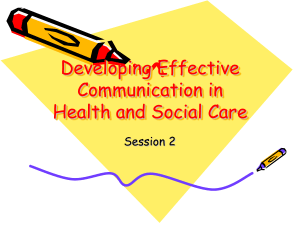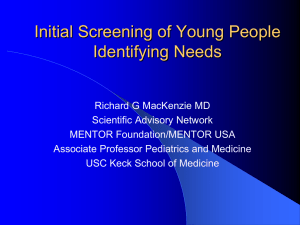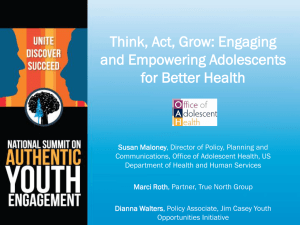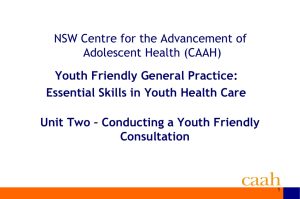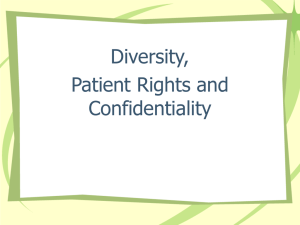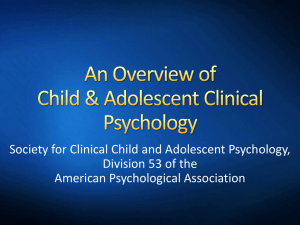MCHBWebinarConfidentiality-Presentation-FINAL
advertisement
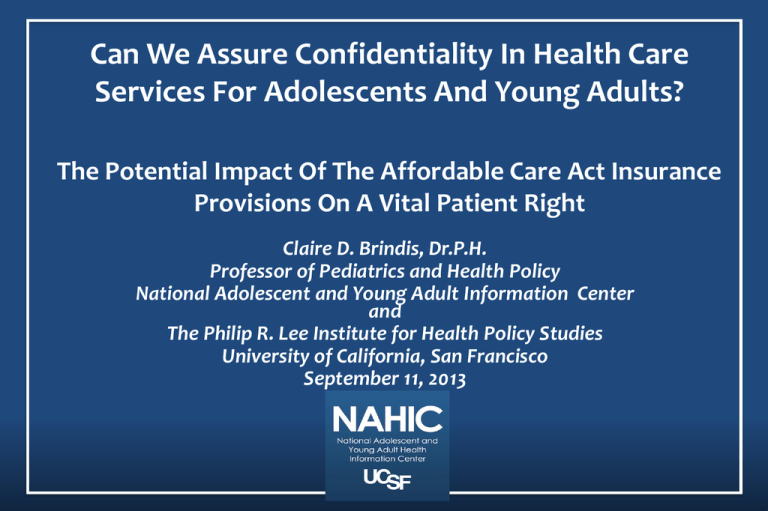
Can We Assure Confidentiality In Health Care Services For Adolescents And Young Adults? The Potential Impact Of The Affordable Care Act Insurance Provisions On A Vital Patient Right Claire D. Brindis, Dr.P.H. Professor of Pediatrics and Health Policy National Adolescent and Young Adult Information Center and The Philip R. Lee Institute for Health Policy Studies University of California, San Francisco September 11, 2013 Special Thanks! M. Jane Park, MPH, Kathleen Tebb, PhD, Charles E. Irwin, Jr., MD, & Elizabeth Ozer, PhD, Linda Ha, and Jazmyn Scott, MPH National Adolescent and Young Adult Health Information Center Division of Adolescent and Young Adult Medicine Department of Pediatrics University of California, San Francisco Abigail English, JD Center for Adolescent Health and the Law Trina Anglin, MD, PhD Maternal and Child Health Bureau Health Resources and Services Administration 3 Objectives • To identify specific adolescent and young adult health needs. • To describe the health care system’s capacity to respond to these needs. • To identify how expanded health insurance provisions, including preventive health services, within the Affordable Care Act (ACA) make it imperative to address issues of confidentiality for adolescent and young adult health care visits. Health Issues of Adolescence & Young Adulthood A unique opportunity to support adolescents to become more responsible for their own health care, as part of their growing independence and transition into young adulthood. The major health problems of late adolescence and early adulthood are largely preventable. Many negative health outcomes are linked to behaviors that can be prevented. Few youths have serious impairment that interferes with daily functioning, BUT Those with chronic conditions, including mental health disorders, must learn to manage these conditions with increasing independence. Trajectories 6 Critical Health Issues of Adolescence & Young Adulthood Within a Developmental Context Increasing independence in habits related to: * diet, physical activity, and sleep. * how they spend their time and form relationships (e.g., more opportunities to become engaged in romantic and sexual relationships), * use alcohol and drugs, * to work, perform community volunteer service, to get into trouble with the law. • Critical period to prevent chronic conditions of adulthood, in areas such as*: • • • • Diseases related to tobacco use, Obesity, Dental caries, Hearing loss. *Adapted from the Healthy People 2020 Core Indicators for Adolescent and Young Adult Health Critical Health Issues of Adolescence & Young Adulthood • Critical period for emergence of mental health concerns, such as: • Major depressive episodes; • Suicide and suicide attempts. • Substance use, including binge drinking, use of marijuana & other illicit drugs, and abuse of prescription drugs). Critical Health Issues of Adolescence & Young Adulthood • Violence, including homicide, fighting and weapon carrying, and homicide. • Motor vehicle crashes & drinking and driving. • Reproductive & sexual health, prevent sexually transmitted diseases, HIV/AIDS, and pregnancy. CHANGING Context for Young Adulthood 10 Before ACA: Health Care Systems Fell Short For Young Adults •Among those with a past-year primary care visit, less than a third received preventive services related to key health issues. •Young adults have very high rates of ER visits – only the very young and the elderly have higher rates. •17% of young adults (ages 18-24) had a past-year unmet need for dental health care (2010). Fortuna et al, 2009, Irwin et al., 2009; CDC/NHIS 2010 Percentage of Visits During Which Preventive Counseling was Provided to Young Adults, 1996 to 2006 All Specialties Primary Care Ob/Gyn Any 30.6% 32.7% 33.6% Injury 2.4% 3.1% 0.8% Smoking 3.1% 4.2% 3.1% Exercise 8.2% 9.4% 8.2% Weight reduction 3.0% 3.8% 3.4% Mental health 4.1% 4.2% 1.3% STD/HIV 2.7% 2.6% 7.1% Diet 10.0% 12.4% 12.4% Adapted from “Ambulatory Care Among Young Adults in the US”, Fortuna, et al, 2009 Young Adults (19-29) experiencing past-year access problems due to cost, 2011 Source: The Commonwealth Fund Health Insurance Tracking Survey of US adults, 2011 Unmet Needs: Mental Health Past Year Treatment for Mental Health and Substance Abuse / Dependence Problems among Those with Problem, by Age, 2010 % who received treatment 70 63.8 60 50 47.2 49.4 40 18-25 30 26-34 31 20 17.3 10 11 6.6 6 0 Serious Psychological Stress Major Depressive Episode Alcohol Abuse/Dependence National Survey on Drug Use and Health, 2010 Drug Abuse/Dependence Before ACA: Health Care Systems Often Also Fell Short for Adolescents • Only 40% of adolescents had a past-year well visit. Among those, very few receive recommended preventive services; rates were particularly low for Hispanics and females (2001-2004). • 54% of adolescents received care in a medical home (2007). This figure is even lower for some populations: 46% among those with a mental health condition, and 35% among those with both a physical health condition AND a mental health condition. • 8.3% of adolescents had a past-year unmet need for dental health care (2010). Irwin et al., 2009; Adams et al., 2013; CDC/NHIS 2010 Obama signing Healthcare Reform Bill March 23, 2010 The Promise of the ACA If fully implemented, the ACA has the potential to improve adolescent and young adult health in at least three ways: 1. Increase the number of adolescents and young adults with insurance coverage; 2. Increase access to preventive services among those with insurance; and 3. Improve health care access and information more generally. Brief Health Profile of Young Adults: International and Over Time 18 Who will receive preventive care services? I am interested in finding out more about how the implementation of the Affordable Care Act will impact adolescent and young adult males regarding preventative services and access to primary care services. Preventive Services as Part of the ACA • No cost sharing in private health plans • Scope USPSTF grade A or B recommended services Bright Futures recommended services for adolescents CDC Advisory Committee on Immunization Practices (ACIP) recommended vaccines Services recommended in Women’s Preventive Services Guidelines (IOM) Limits of “No Cost” Preventive Services as Part of the ACA • Preventive Services – Coverage and Potential Limitations – Screening – Diagnosis – Treatment • Contraception – All FDA approved methods – Exclusion of coverage for some brands – Religious exemptions & accommodations Health Care Reform The Role of Confidentiality in Adolescent and Young Adult Health The Role of Confidentiality and Consent for Sensitive Services in Assuring Adolescents’ and Young Adults’ Access and Use of Health Care • Confidentiality is a basic tenet of adolescent health care -- impacts willingness to seek medical care, disclose sensitive information, and patient ongoing retention. • While many parents do know about their adolescents’ and young adults’ use of health care, for many, especially those at greatest risk, needed care is foregone if confidentiality is not assured. • “Time alone with their clinician” is recommended by health care organizations as it also helps adolescents develop skills needed as they transition into adulthood. • Federal and State Laws impact protocols and practices within individual health entities. Source: National Resource Council/Institute of Medicine, 2008. Confidentiality: Federal Standards Regarding Sharing of Health Information - Health Insurance Portability and Accountability Act of 1996 (HIPAA) A major goal of the Privacy Rule is to assure that individuals’ health information is: •Properly protected, while allowing the flow of health information needed to provide and promote high quality health care; and •Protect the public's health and well being. The Rule strikes a balance that permits important uses of information, while protecting the privacy of people who seek care and healing. Source: (http://www.hhs.gov/ocr/privacy/hipaa/understanding/summary/privacysummary.pdf . Confidentiality: Federal Standards Regarding Sharing of Health Information - Health Insurance Portability and Accountability Act of 1996 (HIPAA) In most cases, parents are the personal representatives for their minor children: * Parents can exercise individual rights, such as access to the medical record, on behalf of their minor children. * However, in certain exceptional cases, the parent is not considered the personal representative. * In these situations, HIPAA defers to the State and other laws to determine the rights of parents to access and control the protected health information of their minor children. Source: (http://www.hhs.gov/ocr/privacy/hipaa/understanding/summary/privacysummary.pdf HIPAA and the Special Case of Minors • If State and other law is silent concerning parental access to the minor’s protected health information, a “covered entity” (e.g., provider) has discretion to provide or deny a parent access to the minor’s health information, provided the decision is made by a licensed health care professional in the exercise of professional judgment. Source: http://www.hhs.gov/ocr/privacy/hipaa/understanding/summary/privacysummary.pdf State Laws and Minor Consent & Confidentiality Minor consent laws and confidentiality protections vary from state to state starting at age 12, covering a range of sensitive services (mental health, substance use, reproductive health). Contraceptive Services: • 25 states and the District of Columbia allow all minors (12 and older) to consent to contraceptive services; • 21 states allow only certain categories of minors to consent to contraceptive services; • 4 states have no relevant policy or state law. Confidentiality and Adolescents and Young Adults – Emerging Issues Privacy concerns likely important to young adults in enrollment and provision of care, as well as through the insurance claim process: Sensitive services: Sexuality and reproductive health, mental health, substance abuse, and dating and intimate violence Other health issues Billing and Insurance Claims – Issues for adolescents, young adults and other patient groups Billing & insurance claims may jeopardize confidentiality – Eligibility and Enrollment – Point of Service Enrollment – Explanation of Benefits (EOBs) – Electronic Health Records (EHRs) (also often known as Electronic Medical Records (EMRs) Challenges to Confidentiality Most states do not have clear statutory or regulatory directives regarding EOBs. Conflicts exist between the provision of state insurance laws governing communications that occur in insurance claims process and state laws that provide confidentiality protections for health care information. Examples of reconciling EOBs and Confidentiality-Focus New York • New York does not require health plans to send an EOB if there is no outstanding balance for the patient (e.g., patient pays required copayments at the time of service and health plan covers balance of the provider’s fee). • For sensitive services, EOBs can be sent to patients, if patients specify. • In the case of the ACA, where FDA approved birth control methods will be made available without co-payment on the part of the patient, this approach may be applicable. However, for other sensitive services, other protocols may need to be established. Examples of reconciling EOBs and Confidentiality—Focus: New York • New York and other states allow minors to consent to reproductive health services, STI, mental health, alcohol and drug abuse services, and sexual assault treatment. • Mental Health and other health care providers may not disclose confidential information without permission of the person who consented to health care. • Enrollment in Medicaid for family planning services can be based upon the adolescent’s own income eligibility. • Medicaid does not send EOBs for sensitive services. Electronic Health Records (EHRs) Great contribution to improving health care, but may make medical records more accessible to parents; may find notes from previous visits, such as family planning and STIs, even if EOBs are not required. Navigating Patient Confidentiality – A Clinician’s Voice I’ve been attending our hospital’s design meetings around utilizing a patient portal for our patients. We have been notified by our IT team that we cannot filter out certain diagnoses or problems from the information that patients, or parents, can access. We can filter out pregnancy test results and STI results. However, all medications will be listed. My question for all of you is, if you are utilizing a patient portal at your institution, how are you handling avoiding inadvertent breaches of confidentiality? We are planning on having patients obtain sole access to their patient portal, once they are 13 years of age. But, what about the patient that presents to our Teen Clinic for birth control at age 12? If her parent has access to the patient portal, then her mother could see the birth control pills listed on her medication list, therefore informing the patient that the patient may be sexually active. Thanks in advance for any information you can share with me. I’m thankful that my institution has invited me to these planning sessions. Oftentimes, I am the lone wolf advocating for our teen patients’ confidentiality. California Spotlight: Responding to State Confidentiality Laws— Case Example - Kaiser Permanente • Organization with a preventive health care focus for all ages. • Family and Patient Friendly – balancing the needs of parents to ensure the health of their children, while also balancing the recognized confidentiality needs of adolescents and young adults. • Systems built to reflect the requirements of state policy on access and confidentiality. • Importance of Adolescent Medicine and System Champions— help make sure systems are legally compliant in a way that actually works in real clinical life. California Spotlight: Responding to State Confidentiality Laws— Case Example - Kaiser Permanente Protocols in place for multiple areas of operation: o o o o o o o Call Center Online appointing Lab Pharmacy Injection Electronic Health Record Billing Ongoing system refinements as laws, protocols, and requirements developed. Confidentiality: Reconciling Federal and State Laws Several vendors of EHR/EMR systems state they are unable to block the creation of Explanations of Benefits (EOBs) for confidential care provided to youth. Mailing these EOBs out to the household would be in violation of Colorado state law. Many practitioners opt out of entering coding for the provision of this type of care which decreases the validity of data related to the types of services being provided to youth. What, if any, leverage does the federal government have with these for-profit entities? Protecting Confidentiality – State Policy Example - California • California bill (SB 138) prohibits health insurers/plans from sending EOBs and other insurance communications regarding "sensitive services" • Specifically, if the patient is a dependent on another’s policy, and is less than 26 years old, all such communications would be barred unless the patient authorizes them. • If the patient is NOT a dependent and under 26, there is no automatic barring of sensitive communications, but if that patient submits a nondisclosure request, the insurer will have to honor it. • “Sensitive services" (e.g., prevention, counseling, diagnosis, and treatment related to sexual and reproductive health, including HIV/AIDS, substance use, and mental health) are considered “Preventive Services” under the ACA and therefore must be provided without share of cost. Planning for the Future 40 Forecasting Prediction is always difficult, especially about the future Niels Bohr Conclusion • Adolescents and Young adults = populations with significant health concerns, high rates of uninsured, and relatively low rates of health care utilization • ACA has potential to expand – Health insurance coverage in private plans & Medicaid – Access to important preventive, acute, and chronic care services • Big challenges remain to ensure success in meeting ACA’s promise for adolescents and young adults Challenges to the Success of ACA Adolescents and Young adults who: • Do not enroll in health insurance, • Live in non-Medicaid-expansion states and thus, do not have access to ACA standards for prevention, • Don’t avail themselves of prevention, • Need, but do not seek sensitive services, as a concern about confidentiality of care. • Maintaining patient portals that assure confidential care provision---how will these be sustained after ACA implementation? Selected Sources/Resources • • • • • • • • • • • ACA preventive services URL: http://www.healthcare.gov/news/factsheets/2010/07/preventive-services-list.html Adams SH, Newacheck PW, Park MJ, Brindis CD, Irwin CE, Jr. Medical Home for Adolescents: Low Attainment Rates for Those with Mental Health Problems and Other Vulnerable Groups, Academic Pediatrics, 2013;13(2):113-121. Centers for Disease Control and Prevention. National Health Interview Survey, 2010. [private data run]. Available at: http://www.cdc.gov/nchs/nhis.htm. English A et al. Confidentiality for Individuals Insured as Dependents: A Review of State Laws and Policies. New York: Guttmacher Institute and Public Health Solutions, 2012, www.guttmacher.org/pubs/confidentiality-review.pdf English A, Park MJ. The Supreme Court ACA Decision: What Happens Now for Adolescents and Young Adults? Chapel Hill, NC: Center for Adolescent Health & the Law; and San Francisco, CA: National Adolescent and Young Adult Health Information Center, 2012, www.nahic.ucsf.edu Fortuna RJ, Robbins B, Halterman JS Ambulatory care among young adults in the United States. Ann Intern Med. 2009;151(6):379385. Irwin, CE, Jr., Adams SH, Park MJ, & Newacheck, P. (2009). Preventive care for adolescents: Few get visits and fewer get services. Pediatrics, 123(4), e565-72. Kaiser Family Foundation. State Health Facts – State Decisions for Creating Health Insurance Exchanges and Expanding Medicaid as of May 2, 2013, http://kff.org/health-reform/state-indicator/state-decisions-for-creating-health-insurance-exchanges-and-expandingmedicaid/. National Resource Council/Institute of Medicine. (2008). Adolescent Health Services: Missing Opportunities. Washington DC: National Academies Press. Substance Abuse and Mental Health Data Archive. National Survey on Drug Use and Health [NSUDH online database]. National survey on drug use and health, 2010 data. Available at: http://www.icpsr.umich.edu/icpsrweb/SAMHDA/sdatools/resources Tebb, K, Brindis, CD, Giordano, A, Combellick, S., Bausch, S, and Diaz A. A shifting Health Landscape for Adolescents and Young Adults: Planning foe the Implementation of Federal Health Care Reform in New York. San Francisco, CA: Philip R. Lee Institute for Health Policy Studies and Division of Adolescent Medicine, Department of Pediatrics, University of California, San Francisco; December, 2012. http://healthpolicy.ucsf.edu

